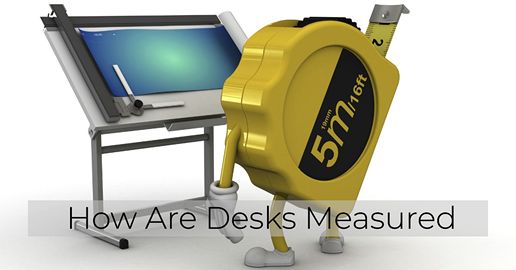
Measuring a desk is an essential first step when purchasing or creating new furniture for your home or office. After all, each room requires different sized furnishings – and any mistakes in measuring can cause space issues and poor organization.
Table of Contents
How to Measure a Desk Correctly: Tips and Tricks
Step one in measuring a desk is to select its location. Consider what functions it will serve, such as holding computers, books or other items that need storage, and this will help determine its size and shape.
Once you have determined a position, measuring can commence. Start by taking measurements for office furniture height on a flat surface and distance from floor to table surface – be aware that table height must suit both your and other people’s height requirements for working or resting comfortably.
Next, measure the width and length of the table surface. If your desk is used for computer work, ensure ample room for keyboard, mouse and screen use. If other items, such as books or documents, will be located within your office space, consider their dimensions when establishing their width and length.
Measure Correctly The Importance of Accurate Measurements
Correct measurements are critical when purchasing and placing furniture indoors. Accurate measurements depend on expected dimensions and how it will be used.
Height is one of the key metrics when measuring tables. Knowing the appropriate size for every family and workforce will enable you to find an office that provides maximum comfort during work or lunch, with chairs of appropriate height and support available – incorrect office height can lead to poor back and neck posture and cause physical discomfort.
Not only should height be considered when designing a table, but its width and length should also be assessed – these depend on user preference and room size; when done right they ensure maximum seating capacity while also permitting free movement around it.
Be mindful when selecting the shape of a table; its dimensions will impact its visual appeal and ability to blend into your interior style. Round, oval or rounded corner designs may be safer and simpler for children in the room.
Correct measurements are integral to providing an ergonomic workspace, including working, socializing and food choices that maximize comfort. Careful measurements help prevent unpleasant surprises while improving quality of life in any room.
Dimensions for All Desk
Desk measurements are integral in selecting furniture to meet a room’s specific requirements and purchasing an office suite that best suits its functions. Due to a range of different office functions taking place simultaneously in other rooms, office sizes must match specific requirements.
Before determining how large of a desk can fit within your space, you need to measure it accurately. Take note of both room dimensions as well as other objects occupying physical space such as furniture and appliances in the room – this will determine the maximum size that can fit inside it.
The second step in designing an office is identifying its operational needs. If it will be used as a workstation, all required items (computers, documents and office equipment) should fit easily within its boundaries; otherwise, seating requirements must also be taken into consideration for dining tables.
The third step in measuring a table involves measuring its length, width, and height. You should consult product specifications when taking these measurements if available. Still, it would be wiser to check these yourself to prevent mistakes during purchase and potential frustration during this process.
Table dimensions should be considered before purchasing or installing furniture since having an ideal table will create harmony in any interior environment and be more practical and convenient in use.
Measuring Table Width and Length
Measuring the width and length of a table is an integral step when purchasing or creating furniture. To do it correctly, it requires using specific tools as well as following some instructions.
- Use metal tape measure in centimeters. Make sure that it’s long enough to cover all widths and lengths of the table, including any gaps between tables or chairs.
- Calculating table width begins with taking measurements at one wider point – usually the top surface – on a foldable table. Measurements should then be taken both when folded up and open for comparison purposes.
- Measure the table length from end-to-end; if an insert or foldable table is inserted, take measurements when unfolded.
- Measure both width and length multiple times, checking yourself and comparing results for more precise readings. Take note of any larger measurements; this will help you select an ideal table size.
- If you don’t have access to metal tape, tape or cord can also be used as measuring devices with regular rulers.
- Before purchasing a table online or Furniture Report, always double-check how the dimensions will appear when folded up or unfolded; this will prevent unpleasant surprises upon delivery of your purchase.
- Please remember that table dimensions may differ depending on its material; wooden tables may exhibit subtle variances due to their natural characteristics.
With these instructions in hand, it should be possible to properly measure the width and length of a table to select or build furniture quickly and successfully. Doing this will save both time and frustration in finding your ideal table!
Consider Height When Measuring Tables
When measuring tables, it is vitally important to consider their height in terms of comfort for their users. A table’s height depends on its interaction between its surface and any chairs or armchairs present on its surface – the exact amount will depend on their use and where exactly on its surface they sit.
A table height can be estimated by comparing it with its user’s. When sitting at a table, it is advised that shoulders be relaxed while forearms rest at an approximate 90-degree angle. This standard height being 75 cm, but this may change according to individual preferences and anatomical needs.
Note that office heights may differ depending on their purpose. While a standard desk height may be sufficient for writing tasks, working on a computer or reading may necessitate lower office heights to keep the body in an appropriate posture and prevent neck or back strain.
To determine the ideal height, tables with recommendations for different activities may help find your optimal size.
Consider your seating arrangements (chairs or armchairs) carefully to ensure a comfortable position.
As well as table surface height, other considerations must be made such as width and depth of table surfaces; presence of drawers/shelves for storage purposes; material used for the table base; a color choice to complement overall interior style.
Required Equipment
To accurately measure a table, several tools are needed. These tools include the following.
- Ruler or tape measures: are an accurate way of measuring table length and width; we advise using a metric system of measurements for more precise results.
- Level: To determine how flat your table sits on its surface. This step is especially crucial if your floor or desired location for table placement differs from the standards.
- Paper and pencil: useful tools for keeping track of measurements and notes. You can accurately record desk dimensions and anything else you deem important.
- Camera or smartphone: For taking measurements and photos.
As you prepare to measure your desk, remember that other tools may provide more accurate and useful results – for more complex tables a laser meter or angle meter may come in handy.
Material selection will depend on your task at hand and available tools; however, since measurement accuracy directly impacts quality and usability of tables, we suggest selecting an instrument with as accurate a measurement process as possible.
How do You Measure an L desk?
Let’s unravel this puzzling mystery and measure up the twists and turns of these cleverly shaped workstations! Imagine this: An L-shaped desk is like a cunning maze, offering ample space for work and creativity. But measuring it? That’s the adventure we’re diving into!
To measure an L desk, start by grabbing your trusty tape measure, just like a treasure hunter with their map. Begin at one end of the desk and measure the length of the longest side, extending your tape measure along the edge. This length determines one side of the “L.”
Next up, move along to the shorter side, measuring from the corner where the two sides meet to the end. It’s like navigating through the twists and turns of a labyrinth to find the hidden treasure. This measurement completes the other side of the “L.”
Once you’ve got these two measurements – the length of the longest side and the length of the shorter side – jot them down like a seasoned explorer marking their findings on a map.
And here’s the kicker – to determine the total size of your L desk, simply add these two measurements together. It’s like solving a riddle to unveil the total workspace available at your disposal!
Voila! You’ve successfully measured an L-shaped desk, revealing its dimensions like a secret revealed at the end of an adventure. With these measurements in hand, you’re all set to find the perfect spot for your cleverly shaped desk and maximize your workspace like a pro!
Characteristics of various materials
Selecting the materials used to construct a table is of utmost importance. Different materials have their own specific qualities that impact its quality, durability and appearance.
Wood is one of the most beloved materials used for tables. It offers natural beauty and stability. Wooden tables can be constructed from various varieties of wood such as oak, pine and toneri. Each type can bring its own set of colors and textures; maintaining wooden tables requires special care as they regularly renew their protective coating.
Metal tables are another popular material choice, offering strength and durability. Made of stainless steel, aluminum or iron they’re great for outdoor or damp areas and feature various finishing options including powder coating or chrome plating to complete their look.
Glass tables are another popular material, adding lightness and elegance. Crafted of either tempered glass (for increased durability) or regular glass, these versatile pieces come in different shapes and sizes to meet modern interior needs perfectly.
Plastic tables are a prevalent choice for children’s and picnic tables, especially lightweight, durable tables designed specifically for outdoor use. Plastic is lightweight yet strong enough for repeated outdoor use without breaking under pressure or deformation and comes in an assortment of colors and designs to choose from. Regular maintenance must also be conducted on plastic tables in order to keep their appearance.
Measuring Tables
Accurately measuring a table is an integral step in selecting furniture. Improper measurements may lead to uncomfortable usage and make an unsuitable fit with your room style; to prevent mistakes and select the ideal table for your space there are a few instructions you should abide by.
Before measuring, it’s essential to determine its purpose – for instance, a kitchen table requires different dimensions than those used for lounge or dining table purposes. This will enable you to choose dimensions and designs accurately.
An average dining room typically measures 90-100 cm wide, though this may change based on the number of seats. A standard version stands at approximately 75 cm but can be tailored based on chair height. In order to determine table length accurately, it is necessary to know how many people it will accommodate; each should expect their bank length of 60-70 cm when anticipating.
Before purchasing a table for any given room, accurate measurements must be taken so as to avoid taking up too much space in an interior and making room too cramped for other furniture or people. Furthermore, measurements must consider distance from walls or other furniture and whether there will be enough space around it.
Overall, taking accurate measurements will allow you to select an office size and style suitable to your needs and modern style. A comfortable and harmonious space for socialization and relaxation can be created by following recommended design procedures and taking part in their creation.
Measure Irregularly Shaped Tables Properly
Measuring an irregularly-shaped table requires extra work and care. Since they’re irregular in their shapes, obtaining accessories or furniture will require precise measurements that require more work to get right.
As part of measuring, the first step should be identifying basic dimensions like length and width. To do this, measure from opposite corners of a table using centimeters for more accurate results.
But measurements alone may not accurately capture the irregular shape of a table, so you must also take the next step when measuring one: determine its surface shape with labels to help explain its irregularities; indicate protrusions, pedestals or irregular edges that have protrusions and thus give a better sense of its form when selecting appropriate furniture for its future use.
Measuring irregularly shaped tables requires a more detailed approach and additional tools like tables and lists. Careful measurements and descriptions will aid in making the correct purchase decision when purchasing table furniture and accessories.
Calculating Table Areas
Before measuring a table, its area must first be calculated. This will enable determining an ideal office size and shape that complements its surrounding environment – such as keeping in mind room size, presence of other furniture pieces and movement requirements.
First, measure the area or space where you plan to place the table. Remember that people must have enough free space around it so they can sit comfortably at it; generally, 1 to 1.2 meters should suffice between it and other furniture or walls.
Keep in mind that there should be ample leg room under your table. To ensure comfortable seating, the depth under the table should typically remain around 60 cm while its height is between 25-30 cm; these numbers may differ slightly based on personal preferences and physical attributes of those using it.
General Conclusion
When calculating table surface area, consider whether it is possible to expand it as needed. Some tables feature expansion mechanisms enabling their table surfaces to grow with your needs if available; consider this when selecting an appropriate table size.
Before measuring a table, calculate its surface area by considering factors like room size and leg space requirements, whether there’s leg space under the table; and whether its surface can be extended. This will enable you to select an ideal table size and shape that works seamlessly within your office furniture setup.
Question and Answer [Q & A ]
Q: I need help choosing an accurate ruler for counting my office. What steps should be taken?
A: We recommend using a metal rule or main scale to measure a table accurately. A flat, undamaged ruler will produce accurate measurements; bent or damaged rulers could result in inaccurate readings.
Q: How can I measure the length of an irregular-angled table?
A: To accurately measure a table with non-uniform angles, its length must be measured using a flexible tape such as metal. Begin at one corner and gradually move around its perimeter following its boundary – recording values you count along the way before adding up all these values to find its length.
Q: How can I measure the width and height of a table?
A: To effectively measure your table’s width and height, we advise using a metal ruler. For measuring width, use the distance between opposite edges of its surface as your guideline; when measuring height, use a vertical line from floor level up towards table surface height.
Q: How can I accurately count a table?
A: To ensure accuracy when measuring table surfaces, it is recommended to apply pressure so that the ruler or measurement presses firmly against it and presses directly against the table surface. This will ensure accuracy due to lack of contact between the instrument and table surface and ensure reliable data collection.
Q: How can I reduce measuring errors?
A: To minimize measurement errors on tables, it is advisable to conduct multiple measurements and calculate an average. Also, make sure that the surface on which your measuring tool is mounted is flat and free from dirt; unevenness or presence of dirt could lead to inaccurate readings.
Q: Will different measuring tools produce different results when used to take measurements on tables?
A: Different measuring tools may produce slightly varying results when used to take measurements for tables. For instance, using both a metal ruler and main meter could result in slight measurement variations; but these variances should not majorly affect the final measurement result.






Add comment